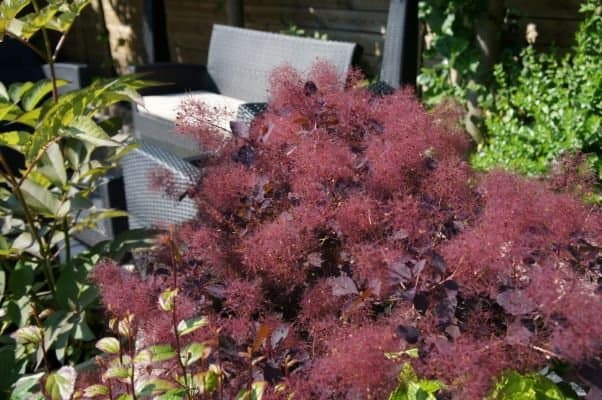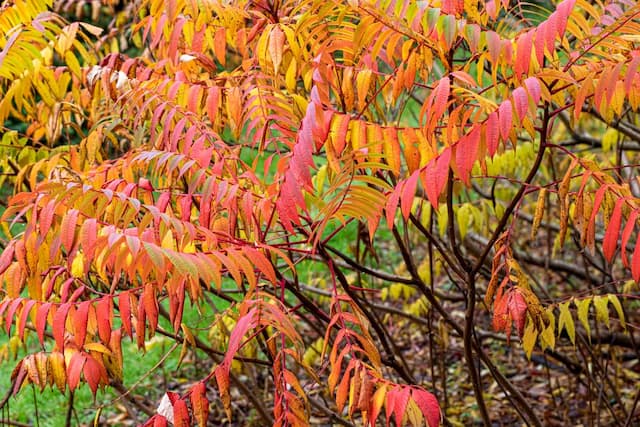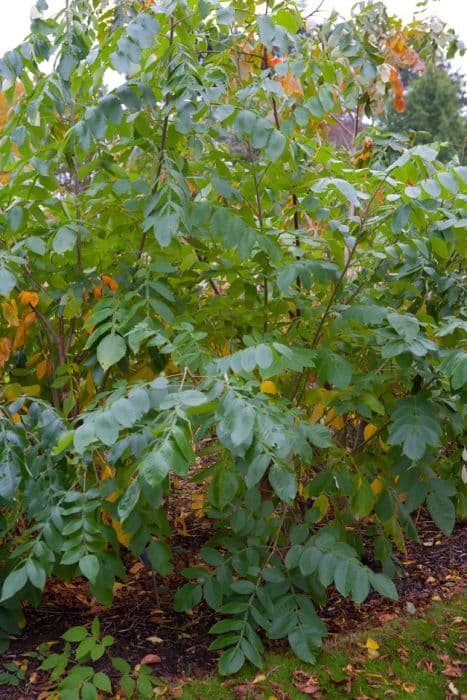Smoke bush Cotinus coggygria Smokey Joe = 'Lisjo' (PBR)
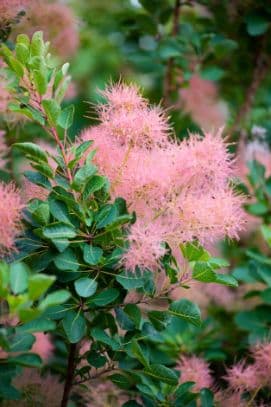
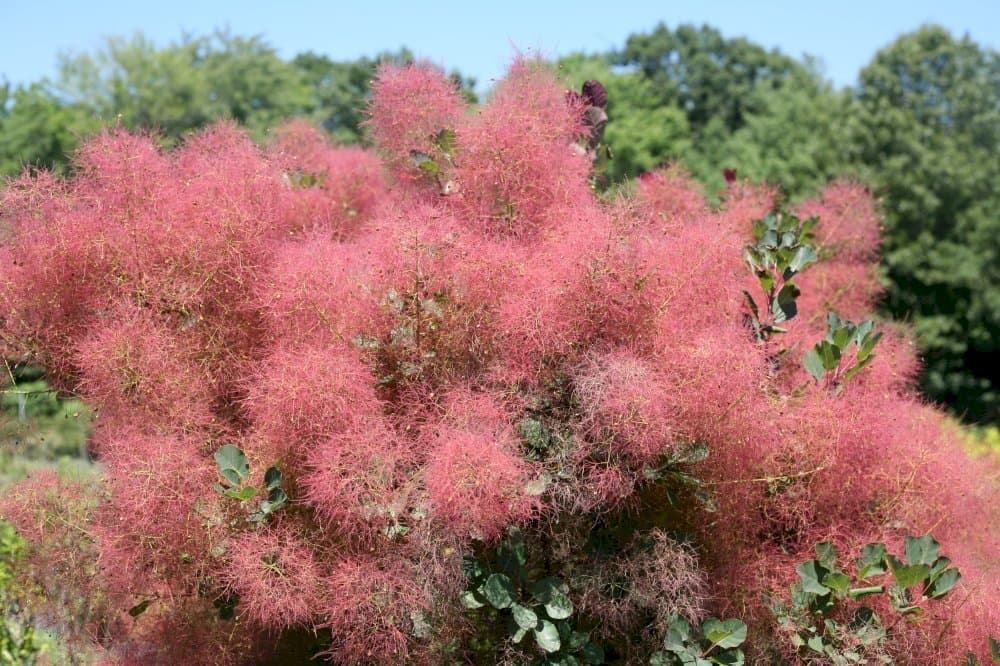
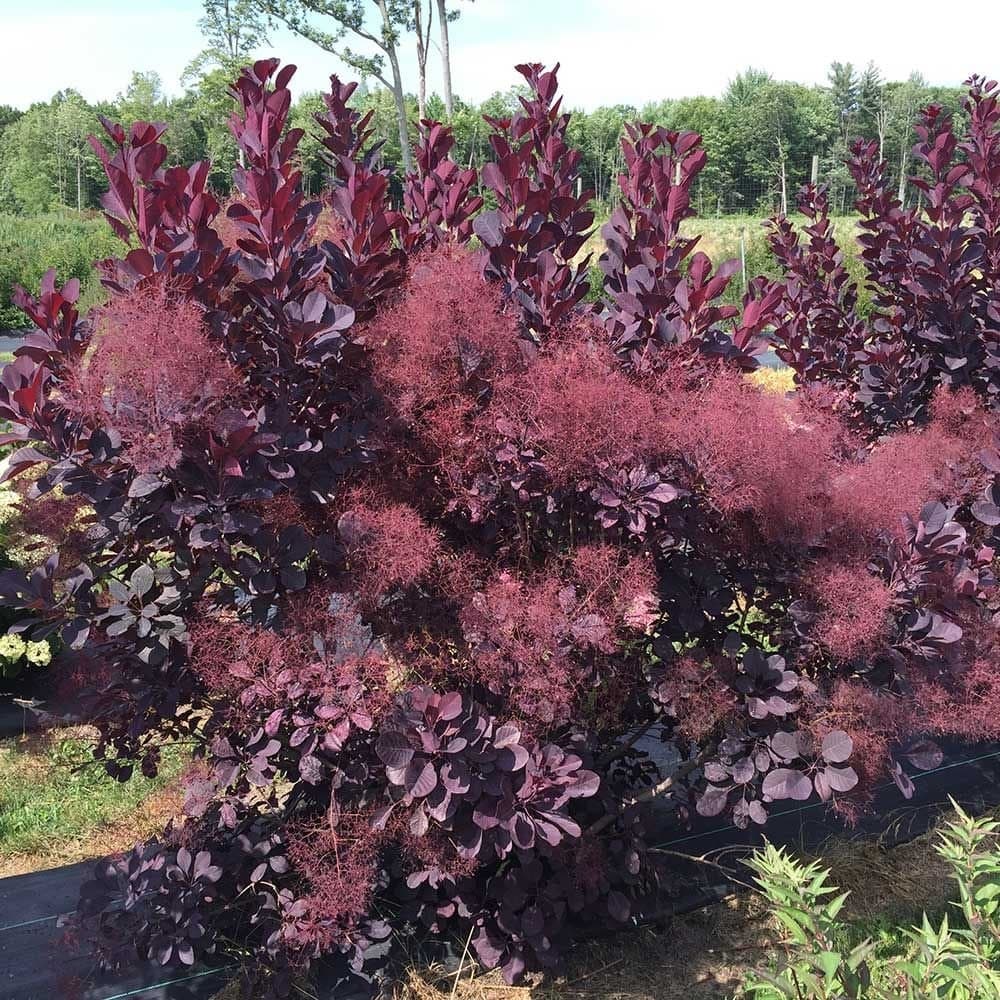
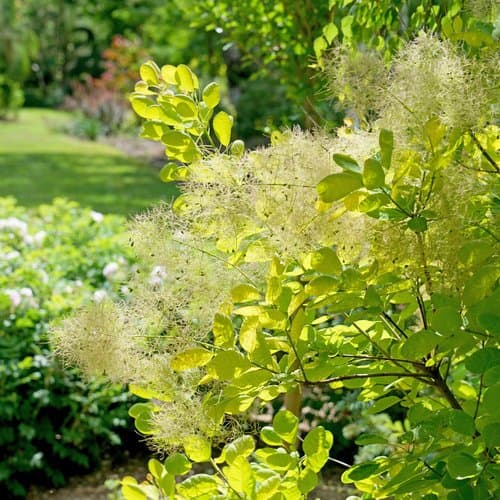
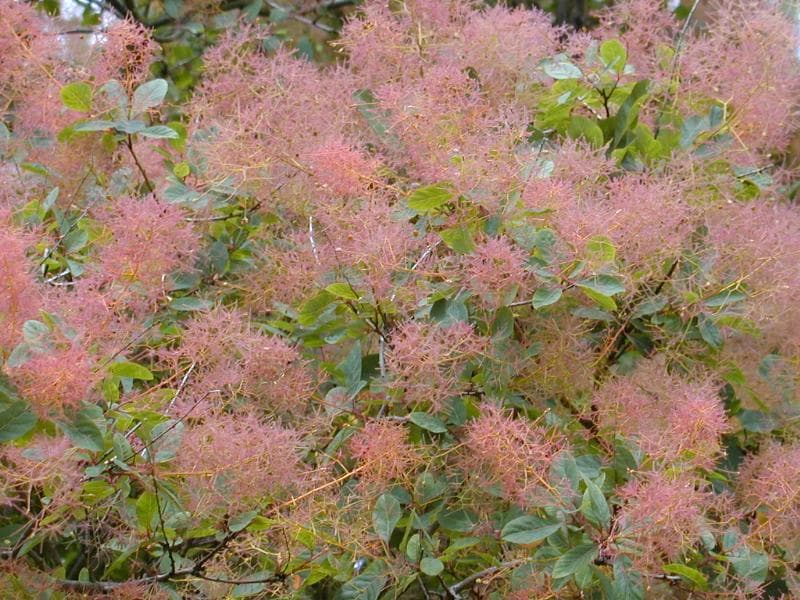
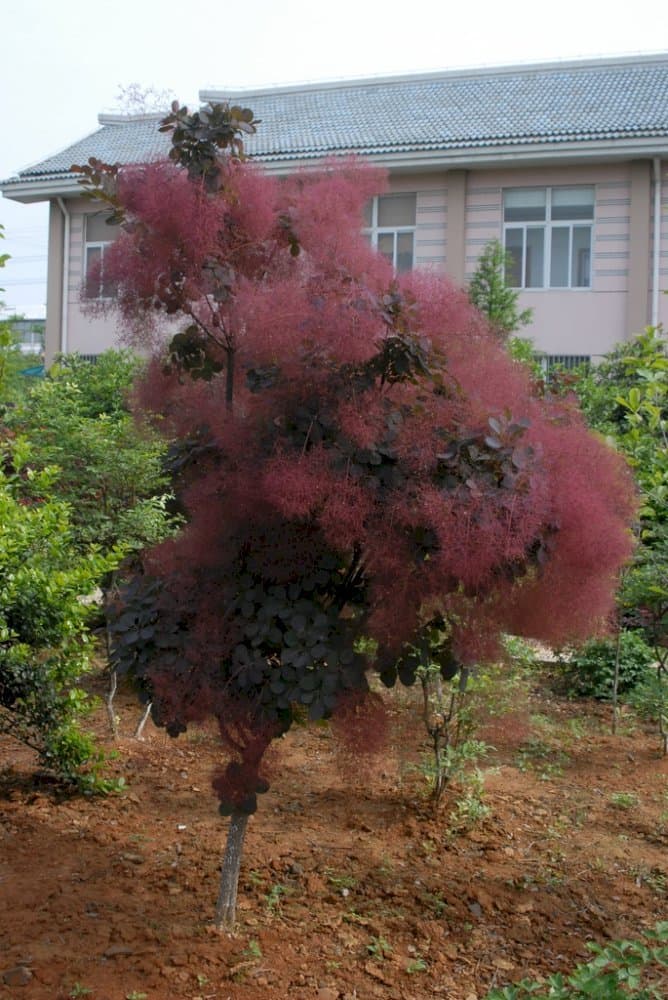
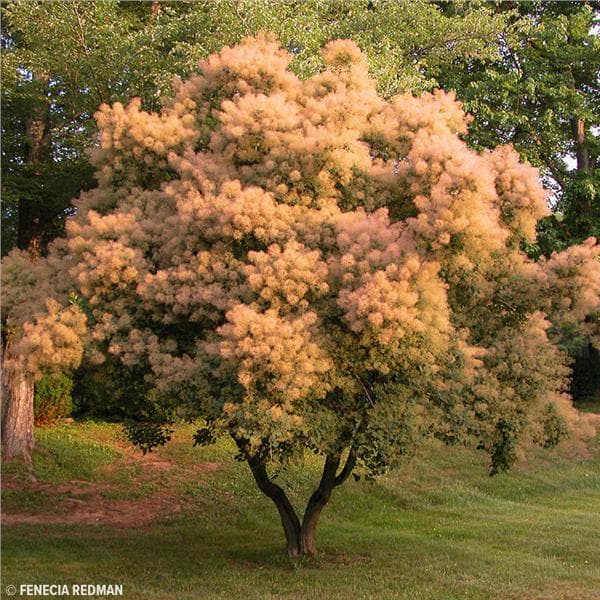
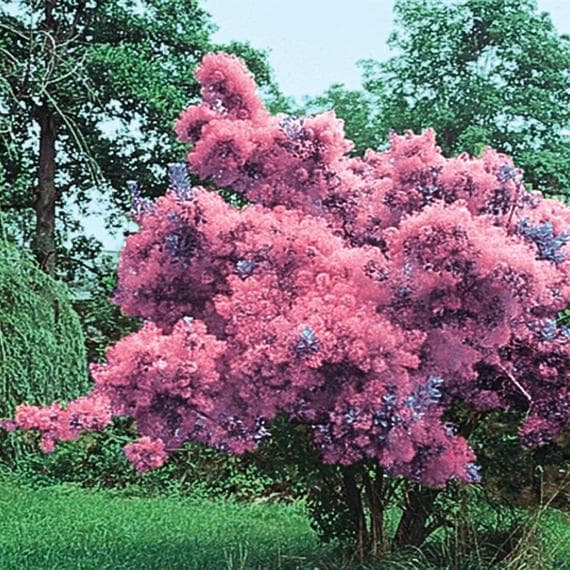
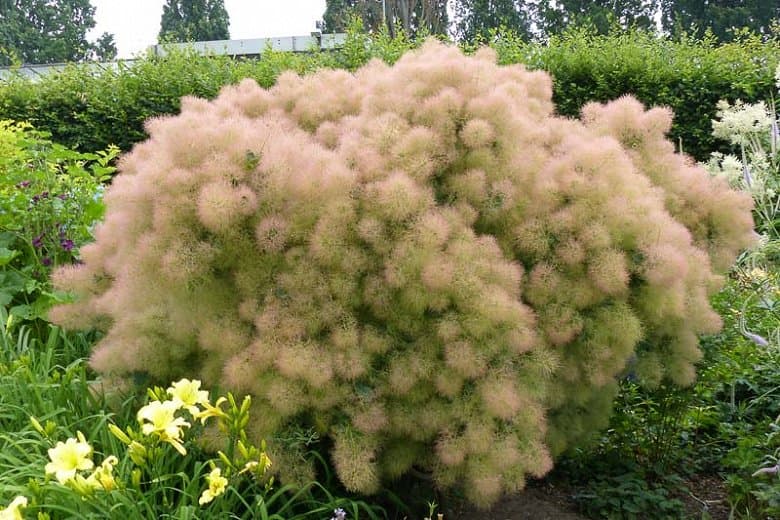
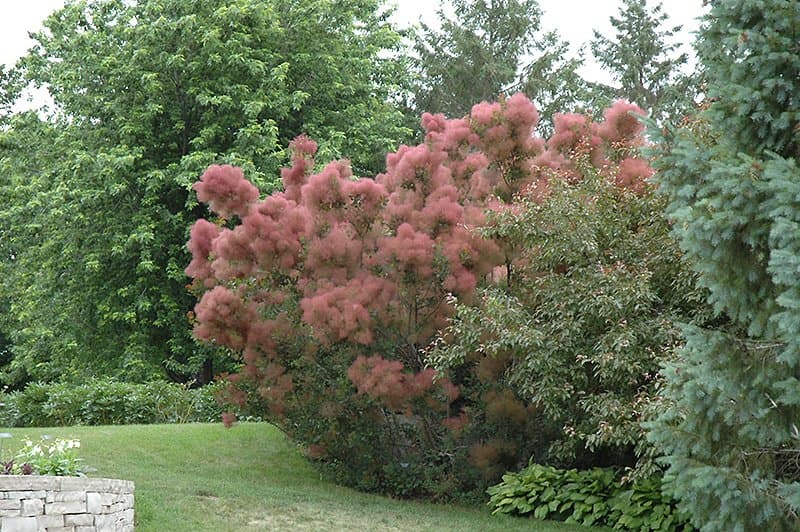
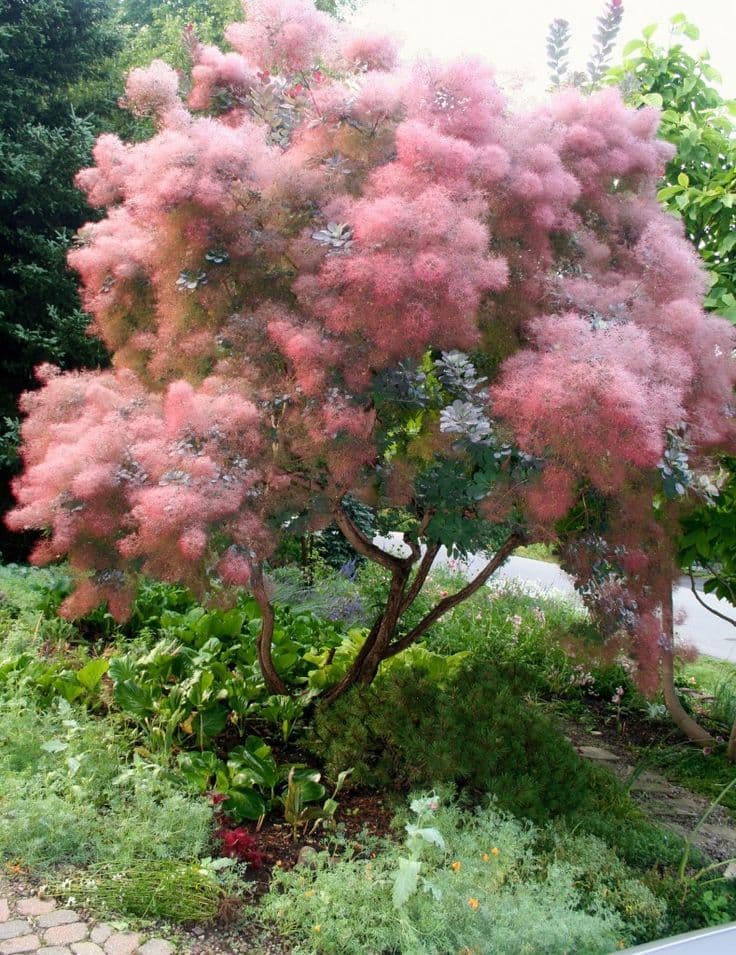
ABOUT
Smokey Joe, known for its distinctive smokey appearance, features a captivating display of foliage and flowers that tend to captivate onlookers. The leaves emerge with an alluring reddish-purple hue that can add a touch of drama to any garden space. As the seasons change, the leaves transition through a range of colors including striking shades of orange and red, often culminating in an impressive autumnal display. What truly sets Smokey Joe apart are its unique, billowy blooms. The plant produces large, feathery plumes that have a smoke-like appearance, thus contributing to its common name. These cloud-like flower clusters usually bear a soft, pinkish-purple color, which contrasts beautifully against the dark foliage beneath. These flowers give the plant a light and airy feel, creating the illusion of puffs of smoke resting amongst the leaves. Smokey Joe's overall structure is rounded and bushy, presenting a dense and compact appearance that can be both elegant and eye-catching. Its branches are strong, making it a durable and resilient addition to the landscape. The combination of its intense leaf colors and ethereal floral display makes it a popular choice for gardeners looking to add a unique and enchanting feature to their outdoor spaces.
About this plant
 Names
NamesFamily
Anacardiaceae.
Synonyms
Smoke Bush, Smoke Tree, Venetian Sumac, Smokey Joe.
Common names
Cotinus coggygria Var. purpureus, Rhus cotinus.
 Toxicity
ToxicityTo humans
The Smoke Tree is not known to be toxic to humans. However, as with any plant, individual allergies or sensitivities could occur. Ingesting any part of the plant is not advisable, and if symptoms develop after handling or ingesting the plant, medical advice should be sought.
To pets
The Smoke Tree is not recognized as toxic to pets. While it is generally considered non-toxic, pets should not be encouraged to eat any part of the plant. If your pet does ingest parts of the Smoke Tree and shows adverse symptoms, consult a veterinarian. Symptoms of plant toxicity in pets can vary but may include vomiting, diarrhea, or lethargy.
 Characteristics
CharacteristicsLife cycle
Perennials
Foliage type
Deciduous
Color of leaves
Varies
Flower color
Pink
Height
10 feet (3 meters)
Spread
12 feet (3.6 meters)
Plant type
Shrub
Hardiness zones
5
Native area
Mediterranean
Benefits
 General Benefits
General Benefits- Ornamental Appeal: Smokey Joe adds visual interest to gardens with its unique, smoke-like puffy flowers and vibrant foliage.
- Low Maintenance: This plant requires minimal care once established, making it ideal for busy gardeners or those with minimal gardening experience.
- Drought Tolerance: It is relatively drought-tolerant, making it suitable for xeriscaping or regions with lower rainfall.
- Seasonal Interest: The plant offers year-round interest with colorful foliage in spring and summer, and attractive fall colors.
- Wildlife Attraction: Its flowers can attract pollinators such as bees and butterflies, enhancing biodiversity in the garden.
- Compact Size: Being a compact cultivar, it is suitable for small gardens, patios, or spaces where a smaller size is preferable.
- Versatility: Smokey Joe can be used in a variety of landscape applications, including borders, focal points, or as a specimen plant.
- Disease and Pest Resistance: It is generally resistant to common pests and diseases, reducing the need for chemical treatments.
 Medical Properties
Medical PropertiesThis plant is not used for medical purposes.
 Air-purifying Qualities
Air-purifying QualitiesThis plant is not specifically known for air purifying qualities.
 Other Uses
Other Uses- The Smoke bush can be used as a natural dye for textiles, providing various shades of yellow and orange, depending on the mordant used.
- Artists sometimes use the leaves and berries of the Smoke bush to create unique inks and paints for their works.
- In woodturning and furniture making, the hardwood of the Smoke bush is appreciated for its fine grain and workability for ornamental pieces.
- Gardeners can use the pruned branches of the Smoke bush for decorative framework in flower arrangements and bouquets.
- The dense foliage of the Smoke bush can provide a privacy screen in gardens and landscapes, particularly when planted in a row or hedge.
- Sustainable landscapes utilize the Smoke bush as a low-maintenance option that requires minimal watering once established, conserving water resources.
- The distinctive purple or reddish foliage can be used to create contrasting color schemes in garden design.
- During the fall, the Smoke bush's leaves can be collected and used as a natural mulch to insulate garden beds and protect plant roots through winter.
- The Smoke bush's dramatic plumes of smoke-like flowers can be dried and used in dried floral arrangements, maintaining their shape and color for a long time.
- Smoke bush wood chips can be used in smoking food, providing a distinct flavor to meats and cheeses.
Interesting Facts
 Feng Shui
Feng ShuiThe Smoke Bush is not used in Feng Shui practice.
 Zodiac Sign Compitability
Zodiac Sign CompitabilityThe Smoke Bush is not used in astrology practice.
 Plant Symbolism
Plant Symbolism- Transformation: The Cotinus coggygria, commonly known as Smoke Tree, undergoes a dramatic transformation with its smokey plume-like flower clusters, symbolizing change and the ability to evolve.
- Mystery: The smoke-like appearance of its blooms can represent the mystical and the unknown, evoking a sense of enigma.
- Illusion: Its ethereal smoke-like flowering gives a sense of illusion, often associated with the magic of nature and the fine line between reality and perception.
- Protection: In some cultures, the billowy and dense nature of the Smoke Tree may symbolize a sheltering presence or a protective barrier.
- Endurance: As the Smoke Tree is hardy and resilient, it can symbolize the ability to withstand hardships and the strength to persist through adversity.
 Water
WaterFor the Smoke Bush 'Smokey Joe', water the plant thoroughly when the top inch of soil feels dry, which typically means once a week, depending on the climate and weather conditions. Use a soaker hose or drip irrigation to apply water directly to the base of the plant, avoiding wetting the foliage to prevent fungal diseases. Each watering session should supply the Smoke Bush with about 1-2 gallons of water, encouraging deep root growth. Adjust your watering schedule during hot, dry periods by increasing the frequency, and reduce watering during rainy seasons or when temperatures drop.
 Light
LightThe Smoke Bush 'Smokey Joe' prefers full sun to partial shade, thriving best with at least 6 hours of direct sunlight daily. Plant it in a location where it can receive unfiltered sunlight for the majority of the day. Partial shade is acceptable, especially in the hottest regions, but too much shade can lead to sparse foliage and fewer of the plant's characteristic smokey plumes.
 Temperature
TemperatureThe Smoke Bush 'Smokey Joe' is hardy and can tolerate a range of temperatures, but it grows best within USDA hardiness zones 5 through 8, which typically offer a temperature range of -20 to 80 degrees Fahrenheit. It can survive minimum temperatures down to -20 degrees Fahrenheit, and while it can withstand heat well, it should be protected from extreme temperature fluxes above 80 degrees Fahrenheit to prevent heat stress.
 Pruning
PruningPrune the Smoke Bush 'Smokey Joe' in late winter or early spring before new growth begins to maintain its shape and encourage denser foliage and more vibrant color. Prune out any dead, damaged, or crossing branches and thin out the center of the plant to improve air circulation. Pruning can be done annually, but the plant can also go several years without pruning if desired.
 Cleaning
CleaningAs needed
 Soil
SoilThe Smoke Bush prefers well-draining soil with a pH of 5.5 to 7.5. A good mix can include loam, sand, and a small amount of organic matter to ensure drainage and fertility.
 Repotting
RepottingSmoke Bush typically doesn't need frequent repotting; once established, it may only need repotting every 3-5 years to refresh the soil.
 Humidity & Misting
Humidity & MistingSmoke Bush is adaptable and does not require specific humidity conditions, making it suitable for average outdoor humidity levels.
 Suitable locations
Suitable locationsIndoor
Smoke Bush isn't ideal for indoor growth due to size.
Outdoor
Plant in full sun, well-draining soil, and space adequately for airflow.
Hardiness zone
5-9 USDA
 Life cycle
Life cycleSmokey Joe, scientifically known as Cotinus coggygia 'Lisjo' (PBR), begins its life cycle with seed germination, which occurs in a warm and moist environment, preferably in spring. Following germination, the seedling emerges, establishing a root system and producing its first set of true leaves. As a young plant, or sapling, it undergoes vegetative growth, forming a robust, multi-stemmed shrub with characteristically round, bushy foliage. Upon reaching maturity, which can take several years, Smokey Joe flowers in the summer, displaying feathery, smoke-like inflorescences that give the plant its common name. After flowering, the plant produces small, hard seeds, which are disseminated by various means, including wind and wildlife, to begin a new generation. Throughout its life, Smokey Joe experiences seasonal changes, with foliage potentially turning vibrant shades of yellow, orange, or red in the fall before entering dormancy in winter.
 Propogation
PropogationPropogation time
Spring to early summer
Propogation: The common name for Cotinus coggygria 'Smokey Joe' is Smoke Bush, and the most popular method for propagating this plant is through softwood cuttings. Softwood cuttings are typically taken in late spring or early summer when the new growth is still green and flexible. Cut a 4-6 inch (10-15 cm) section from the tip of a healthy branch, making sure it includes at least two sets of leaves. Remove the leaves from the lower half of the cutting to expose the nodes where roots will form. Dip the cut end in rooting hormone to encourage root development and plant the cutting in a well-draining potting mix. Keep the soil moist but not waterlogged, and cover the pot with a plastic bag to maintain humidity. Roots should develop within a few weeks, and once established, the new Smoke Bush plants can be transplanted to their permanent location.

